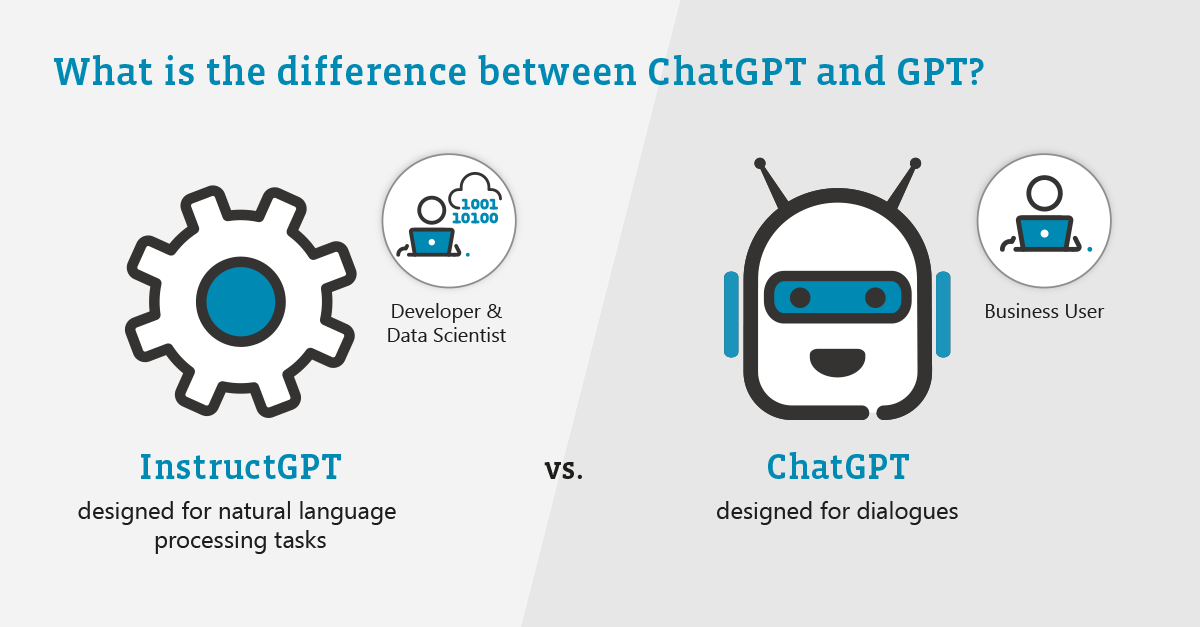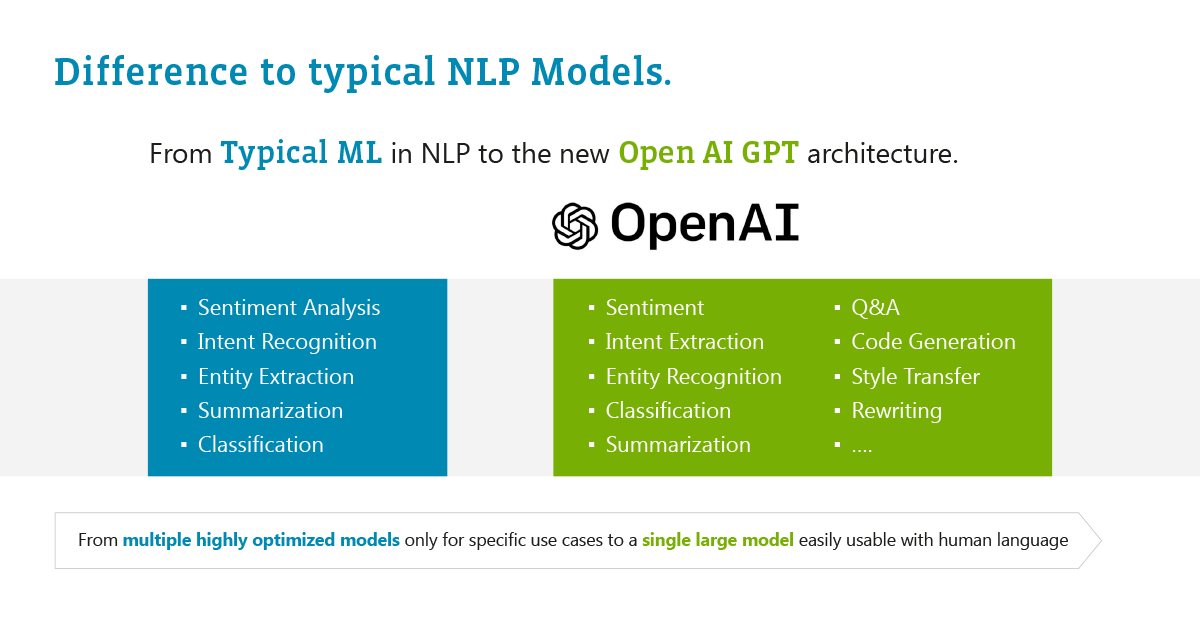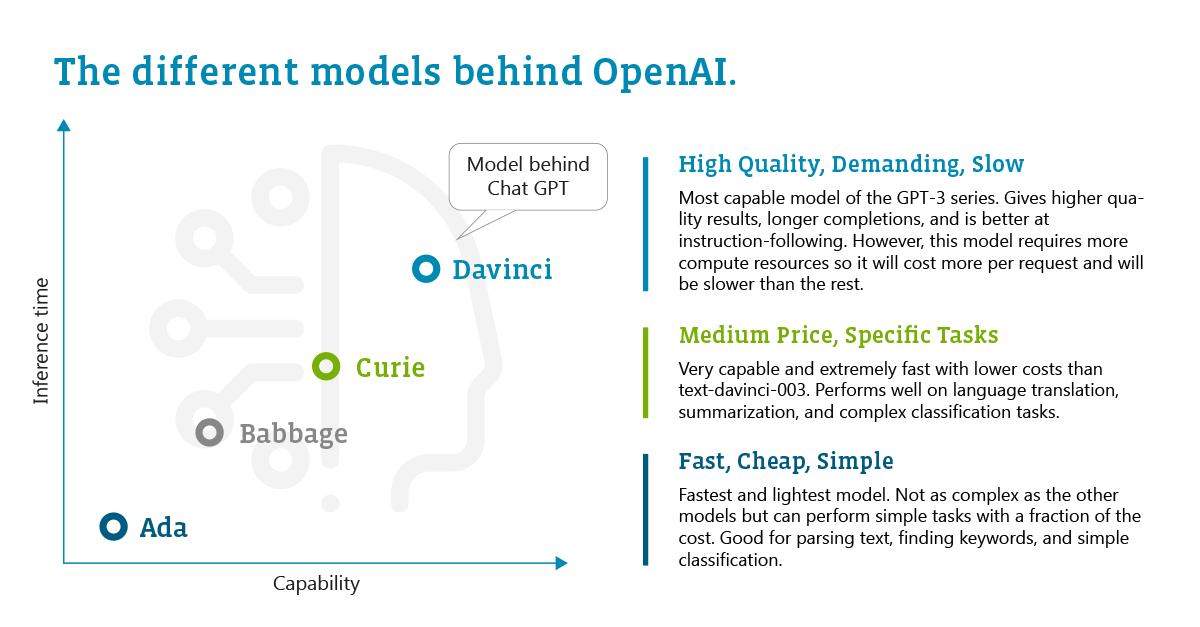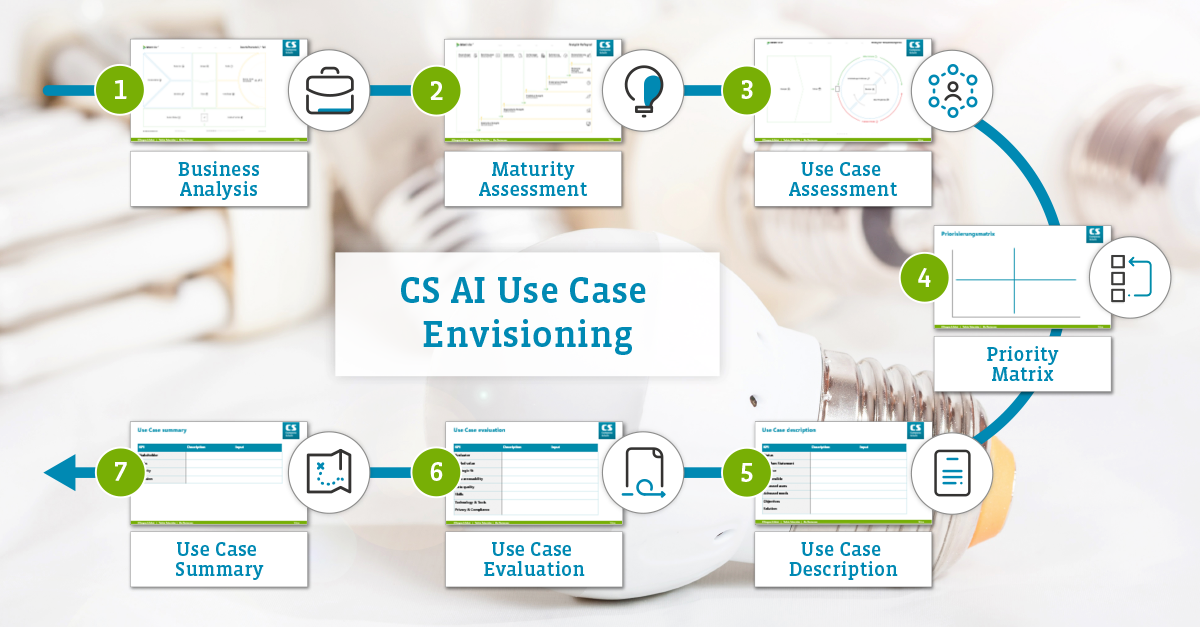1 Introduction
Microsoft Azure OpenAI is at the forefront of cutting-edge technology, which is a cloud-based service that provides access to a wide range of advanced AI models, including generative AI models like GPT-3, GPT-4 and ChatGPT, as well as other model families for tasks such as code generation and embeddings. In this blog article, we aim to provide a practical and simplified introduction to the concept of ChatGPT and InstructGPT, explain what generative AI is all about, describe how AI models are defined, and which models are used by Azure OpenAI, followed by a practical shortcut on prompt engineering. Lastly, we will introduce how we can support your business in identifying and implementing generative AI use cases, setting up Azure OpenAI, and integrating GPT models into your data science projects and existing applications.
2 What is ChatGPT?
There is a significant difference between the Chat Model we all know as ChatGPT and the models you might want to use to integrate them into your business applications to push them to the next level. Let us introduce ChatGPT and InstructGPT. Both are GPT-based models with distinct training and application focuses. ChatGPT is designed for generating conversational responses, trained using a dialogue dataset that includes transformed data and new dialogues where trainers role-play as both user and AI. On the other hand, InstructGPT is designed to produce instructional text-like language translation or generating content and is trained interactively with human instructors that provide corrective feedback. Despite their differences, both models showcase the versatility of GPT (Generative Pretrained Transformer) in generating context-aware text for diverse uses.

3 Understanding Generative AI
Generative AI models, such as GPT-3 and GPT-4, are designed to generate content, such as text or code, based on a given input. These models are pretrained on vast amounts of data and can be fine-tuned to generate content in a specific domain. Generative AI models are capable of understanding natural language, creating human-like responses, and even generating code based on natural language instructions.
As displayed in the following figure, Open AI’s Large Language Models (LLM) offer the capabilities to combine various Machine Learning (ML) task capabilities together in one model. Also, it has to be highlighted that these capabilities can be easily accessed just by using natural language.

4 What is Azure Open AI?
Both model families (InstructGPT and ChatGPT) are available in Microsoft’s Azure OpenAI Service. Azure OpenAI enables you to deploy your own models and choose what best suits your business needs for the task at hand. Additionally, choosing Microsoft Azure OpenAI offers a variety of advantages for enterprises:
- Enterprise-grade capabilities: Azure OpenAI Service offers advanced AI models with the security, reliability, compliance, and data privacy expected from Microsoft Azure. Microsoft is committed to its own compliance promise to provide an array of resources to support its customers in meeting their compliance obligations (e.g. General Data Protection Regulation (GDPR) | Microsoft Learn)
- AI-optimized infrastructure: Azure provides a purpose-built infrastructure for best-in-class performance and scalability for compute-intensive AI workloads.
- Built-in responsible AI: Microsoft implements guardrails that align with responsible AI principles, ensuring ethical use of AI technologies.
- Proven track record and partnership: Leading AI companies choose Azure for innovation, and the ongoing partnership with OpenAI grants access to the latest AI models for enterprise customers.
5 Azure OpenAI Models
Azure OpenAI provides access to a variety of advanced models, each tailored for specific tasks and use cases. In this section, we delve into the details of these models and explore their capabilities and ideal applications.
5.1 GPT-3 Models
The GPT-3 models are designed to understand and generate natural language. They are available in four capabilities, listed below in descending order of power:

As the most capable model, Davinci excels in tasks that require deep understanding of content, such as summarization for specific audiences, creative content generation, complex intent analysis, and cause-and-effect reasoning.
Curie is a powerful yet fast model that performs well in tasks like sentiment classification, summarization, language translation, complex classification, and Q&A. Curie is an excellent choice for general service chatbots.
Babbage is adept at straightforward tasks like simple classification and semantic search, ranking how well documents match up with search queries.
As the fastest model, Ada is suitable for tasks like parsing text, address correction, simple classification, and keyword extraction. Providing more context can often improve Ada's performance.
5.2 ChatGPT (gpt-35-turbo) (Preview)
ChatGPT is specifically designed for conversational interfaces, with a conversation-in and message-out structure. It expects a chat-like transcript format as input and generates a model-written message as output. ChatGPT is ideal for creating chatbots and other conversational applications.
5.3 GPT-4 Models (Preview)
The GPT-4 models build upon the success of GPT-3.5 and offer enhanced capabilities for understanding and generating natural language and code. These models are currently in preview and include:
- gpt-4: This model is ideal for tackling complex natural language understanding and generation tasks, as well as code generation. The specialty is also its ability to understand multimodal input such as images.
5.4 Codex Models
Codex models are designed to understand and generate code. They are even capable of translating natural language into code. The most powerful Codex model is code-davinci-002, offering advanced code understanding and generation capabilities. Potential application areas include a personal assistant for your developers such as the Star Coder LLM or implementing a code generation LLM as a middleware to automatically create software increments such as apps, reports, or other automation scripts.
5.5 Embedding Models
Embedding models are designed to understand and work with embeddings, which are dense representations of the semantic meaning of a piece of text. Vector embeddings are used to convert words into numbers that machines can understand. For instance, the word "apple" might be represented as a list of numbers in a high-dimensional space, with each number capturing a different aspect of its meaning, such as its association with "fruit", "red" and "healthy". In Azure OpenAI, there are three families of embedding models for different functionalities: similarity, text search, and code search. These models are typically used to analyze your unstructured data such as PDF’s or PowerPoint reports and generate a machine-readable form. The output is saved in databases, which can be used for another LLM to make your internal knowledge bases more transparent and easier to access, hence speeding up your organizational decision-making process.
In summary, Azure OpenAI offers a diverse range of models, each designed for specific tasks and challenges. Understanding each model's capabilities and the tasks they excel in can help you harness the full potential of generative AI to improve your business processes and drive innovation as well as to implement a cost-effective solution.
6 Prompt Engineering
To make the most of Azure OpenAI models, it's essential to understand prompt engineering. Prompt engineering is the process of crafting input prompts that guide AI models to produce desired outputs. From our experience, we recommend the following simple tips and examples to help you get started:
Clearly define the task you want the AI model to perform. Instead of "Write about AI," use "Write a 500-word introduction to artificial intelligence and its applications."
Use analogies or examples to clarify your instructions. For instance, "Write a poem about a sunset, similar to how Robert Frost might describe it."
Repeat important instructions or provide cues both before and after the primary content. For example, "Translate the following text into French: 'Hello, how are you?' Doubling down helps ensure clarity of task and reduces the possibility of errors in the AI's response.
The sequence in which you present information can impact the output. Experiment with placing instructions before or after your content and be aware of recency bias in the model.
Provide an alternative path if the model cannot complete the assigned task. For example, "Summarize the following article, or respond with 'Not applicable' if the content is not suitable for summarization."
Prompt engineering will be a crucial skill for the future, as LLMs will increasingly become a partner for many people in their daily work. Hence, this core skill should be taught to every user interacting with these new assistants. This is why we are starting to train our customers in how to engineer their prompt for efficient assistant interaction.
7 Use Case Example
At Campana & Schott, our daily business is helping our clients to enhance their project management capabilities by automating project management processes. A good example is the generation of risks, their analysis as well as the derivation of a risk mitigation action.
However, we do not stop here, we also deal with the creation of a project plan according to your best practices that can be done by the click of a button and has the potential to heavily reduce the manual effort of project managers. To name another example, we came up with an integrated project management assistant to help project managers plan their projects and assist them in their daily tasks such as status reporting or generation.
8 Conclusion
Azure OpenAI offers a diverse range of powerful AI models, each designed to tackle specific tasks and challenges. By understanding the capabilities of these models, such as InstructGPT and ChatGPT, and mastering prompt engineering, you can harness the full potential of generative AI to improve your business processes and drive innovation.
Our consultants understand the immense potential of generative AI and the value it can bring to your business. Our team of experts can help you identify use cases for generative AI, implement them effectively, set up Azure OpenAI, and seamlessly integrate GPT models into your existing applications.
Get started with an AI Use Case Envisioning for general use cases. During our workshop, we will discover collaboratively how your business can reach the next level in a 7-step process:

By leveraging our expertise, you can harness the power of Azure OpenAI to automate tasks, enhance customer experiences, and unlock new opportunities for growth. Whether you are looking to create a conversational chatbot, develop a code generation system, or utilize AI for content generation, we´re here to help you every step of the way.

